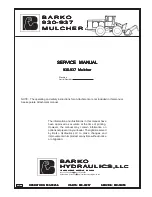
Maintenance—442 Service
3.
Slide the Interface board toward the rear of the 442
to clear the BEAM FINDER and ON/OFF push but-
ton/shaft assemblies from the front panel openings.
4.
Placethe Interface boardinthe access position (90°
from the normal position) by sliding the edge of the board
into the second set of slots in the three plastic circuit board
holders described in Step 2 (check that cables and wires
from the board are clear of other components while the
board is being changed from one position to the other and
that no interconnecting plugs or pin connectors have
loosened during the transition).
5.
To allow rotation of the FOCUS and INTENSITY
controls while the Interface board is in the access position,
reinstall the knob/shaft assemblies onthe potentiometers.
To avoid damage to the potentiometers or the board,
carefully note the orientation of the flatted portions of the
shafts and potentiometers and do not apply excessive
force while reinstalling the knob/shaft assemblies. To
avoid danger of burning the crt phosphor, rotate the
INTENSITY knob fully counterclockwise during initial
turn-on of the instrument.
6.
To return the Interface boardtothe normal position,
reverse the order of the foregoing steps.
PREVENTIVE MAINTENANCE
Introduction
Preventive maintenance consists primarily of cleaning
and visual inspection. When performed on a regular basis,
preventive maintenance can prevent instrument break
down and ensure the reliability of this instrument. The
severity of the environment to which the 442 is subjected
will determine the frequency of maintenance. A con
venient time to perform preventive maintenance is just
prior to recalibration of the instrument.
Cleaning
The cabinet minimizes accumulation of dust inside the
instrument. Operation without the cabinet in place
necessitates more frequent cleaning. The front cover
provides a measure of dust protection for the front panel
and the crt face. Thefront cover should be installed when
storing or transporting the instrument.
INTERIOR.
Accumulation of dust and dirt should be
removed as often as operating conditions require. Dirt can
cause overheating and component breakdown. Dirt on
components acts as an insulating blanket, preventing
efficient heat dissipation. It also provides an electrical
conduction path that can result in instrument failure,
especially under high humidity conditions. The best way
to clean the interior is to blow off the accumulated dust
with dry, low-pressure air (approximately 9 pounds per
square inch). Remove any remaining dirt with a soft brush
or a cloth dampened with a mild detergent and water
solution. A cotton-tipped applicator is useful for cleaning
in narrow spaces or for cleaning circuit boards.
Avoid the use of chemical cleaning agents that might
damage the plastics used in this instrument. Do not
use chemicals that contain acetone, benzene,
toluene, xylene, petroleum ether, white kerosene,
carbon
tetrachloride,
methylene chloride,
trichloroethane,
trichlorotrifluoroethane ( Freon
113, -tf, -ta, -te, -tmc) and trichlorethylene.
Recommended cleaning agents are isopropyl
alcohol, kelite (1 part kelite, 20 parts water), and a
solution of 1% mild detergent and 99% water.
Most spray circuit coolants contain Freon 12 as a
propellant. Because many Freons adversely affect
switch contacts, check the contents and brand name
before using a spray coolant. The following brand
names are acceptable coolants: Artie Freeze, Quik-
Freeze, and Can-O-Gas. Do not use Zero Mist brand
of circuit coolant. The only recommended circuit
coolants for the volts!division attenuators are dry ice
(CO
2
) or isopropyl alcohol.
SWITCH CONTACTS.
Some of the switches in the 442
are circuit-board mounted, cam-actuated contacts. Care
must be exercised to preserve the high-frequency
characteristics of these switches. Switch maintenance is
seldom necessary, but if it is required, observe the
following precautions.
Clean the switch contacts only with isopropyl alcohol,
especially in the area of the vertical attenuator boards.
Carbon-based solvents will damage the boards used for
the attenuators. Apply the isopropyl alcohol with a camel
hair brush. Do not use cotton swabs, as they tend to snag
on contacts, possibly causing damage, and the contacts
may hold strands of cotton, causing intermittent electrical
contact.
EXTERIOR.
Loose dust accumulated on the outside of
the oscilloscope can be removed with a soft cloth or small
paint brush. The paint brush is particularly useful for
dislodging dirt on and around the front-panel controls.
Dirt that remains can be removed with a soft cloth
dampened in a mild solution of detergent and water.
Abrasive cleaners should not be used.
5-2
R E V A M A Y 1980
Summary of Contents for 442
Page 9: ...442 Service 442 Oscilloscope viii REV A MAY 1980 ...
Page 113: ...Figure 7 4 442 Oscilloscope block diagram REV A JUN 1980 2 3 7 4 2 7 A ...
Page 117: ...A8 VERTICAL BOARD Figure 7 6 Vertical circuit board location ...
Page 118: ......
Page 120: ......
Page 122: ......
Page 123: ...Figure 7 8 interface circuit board location ...
Page 124: ......
Page 126: ......
Page 130: ...A ll TRIGGER SWITCH BOARD 2 3 7 4 3 6 A Figure 7 10 Trigger Switch circuit board location ...
Page 131: ...2 3 7 4 S 4 R ev jun VRSO V E R T IC A L OUT PUT CRT t PROBE ADJ 3 ...
Page 133: ......
Page 137: ......
Page 139: ......
Page 140: ...4 4 Z ...
Page 142: ......
Page 148: ...R EV K JUN 9SO ...
Page 153: ... 442 ...
Page 154: ...442 REV A DEC 1978 ...
Page 164: ......
















































